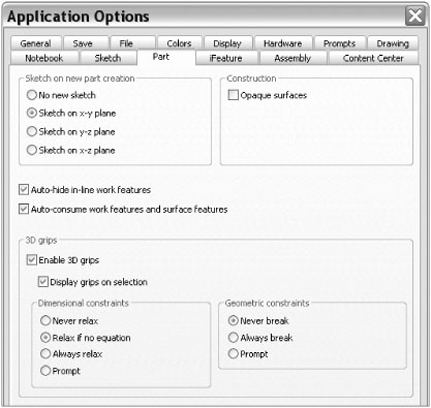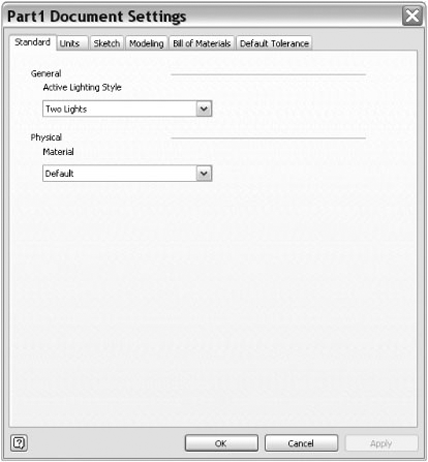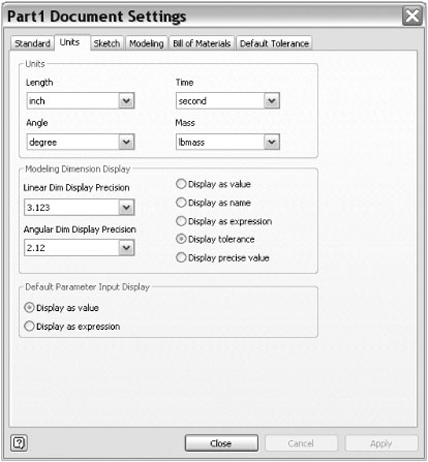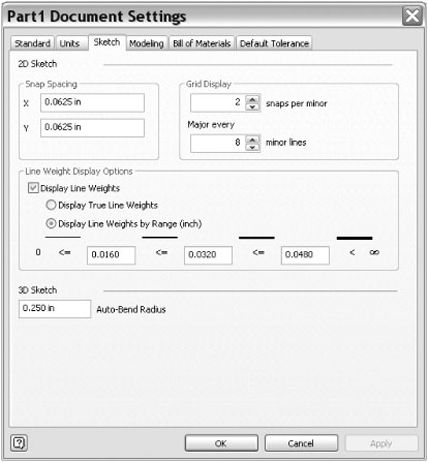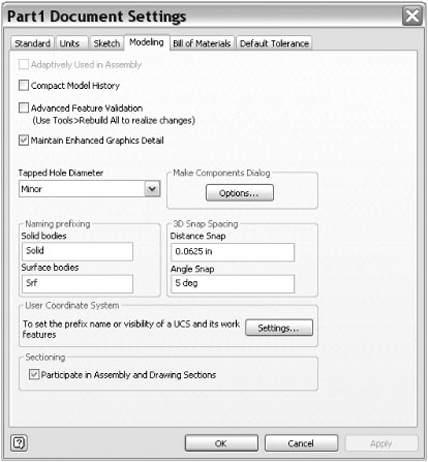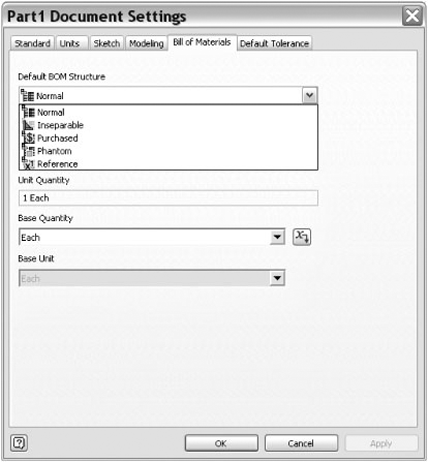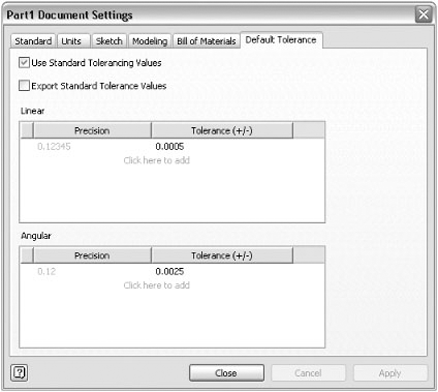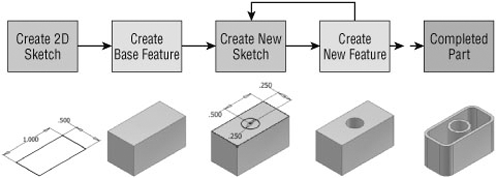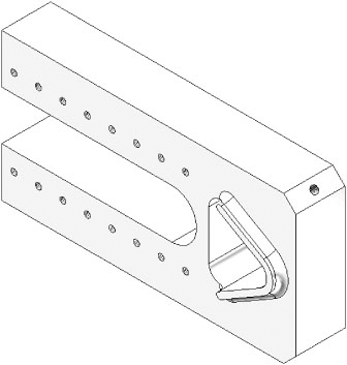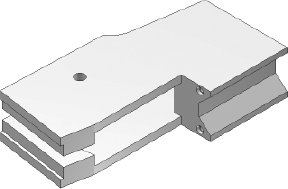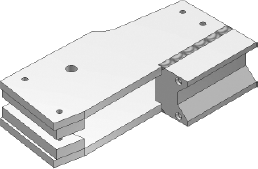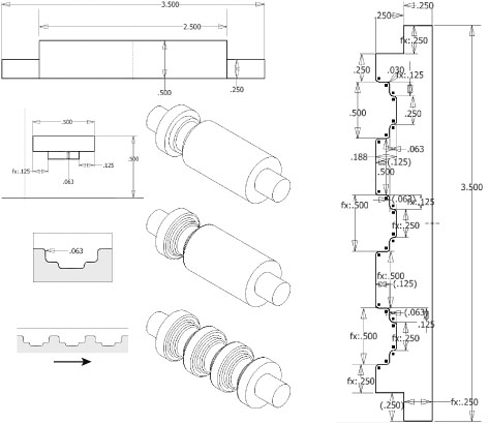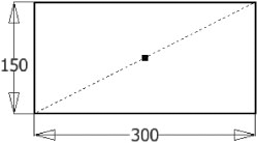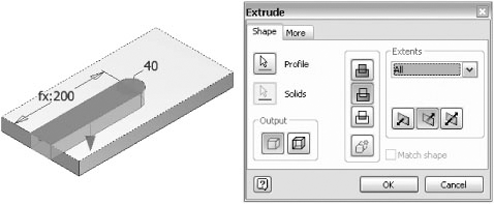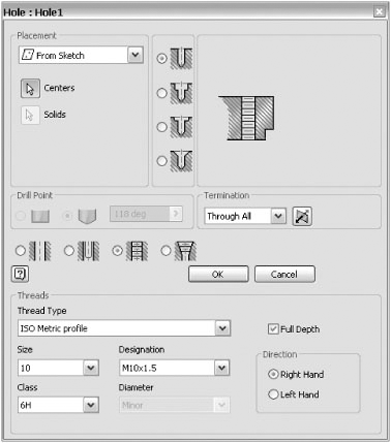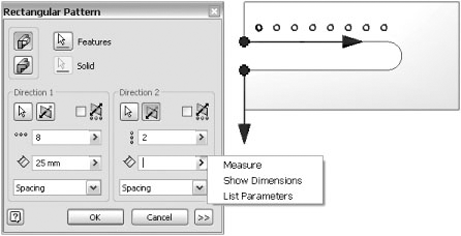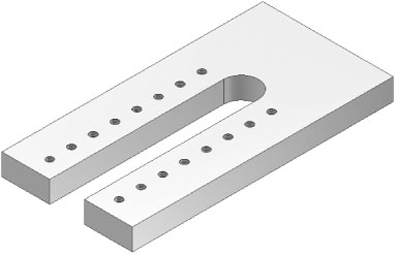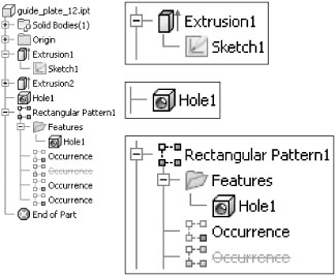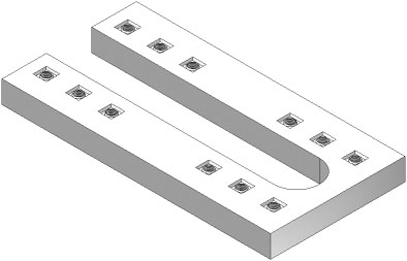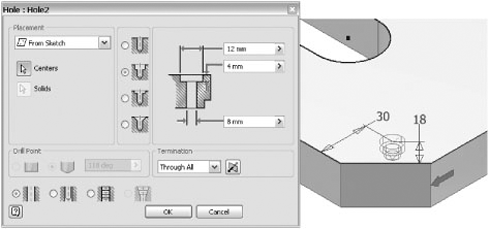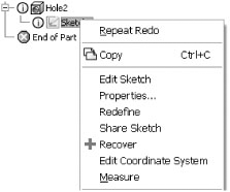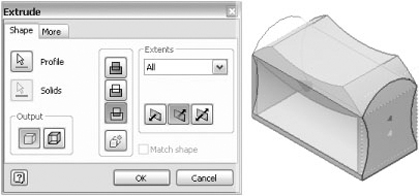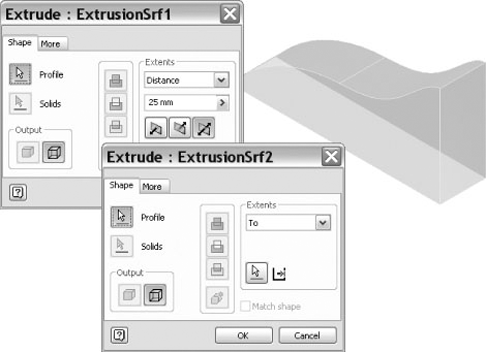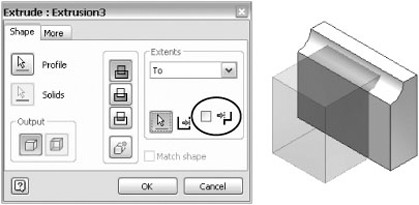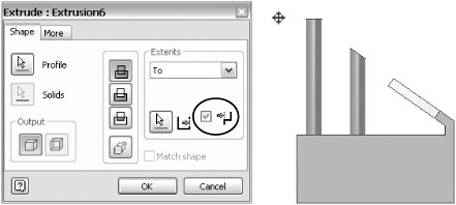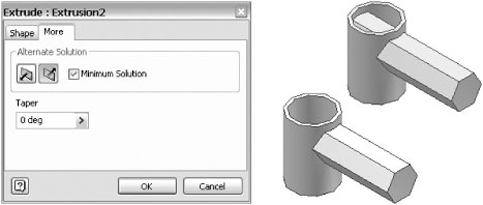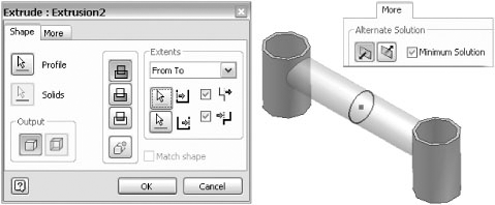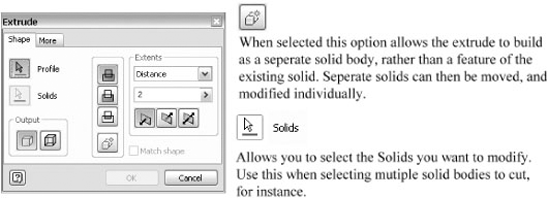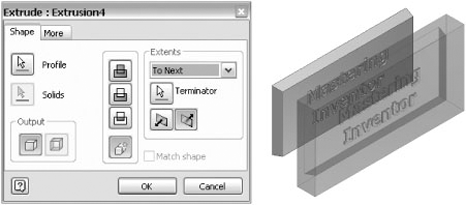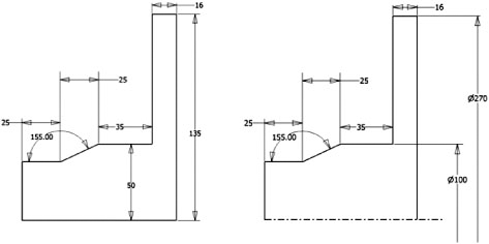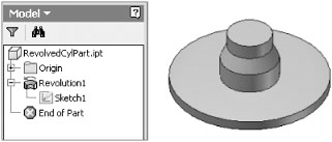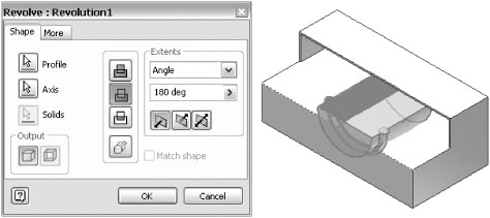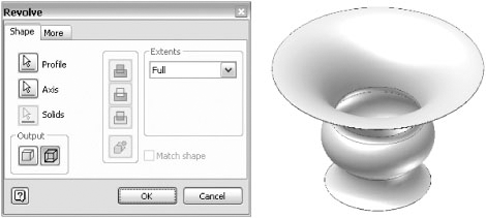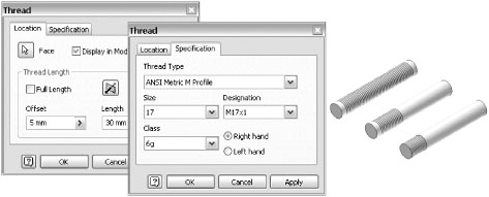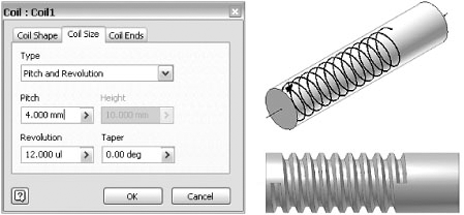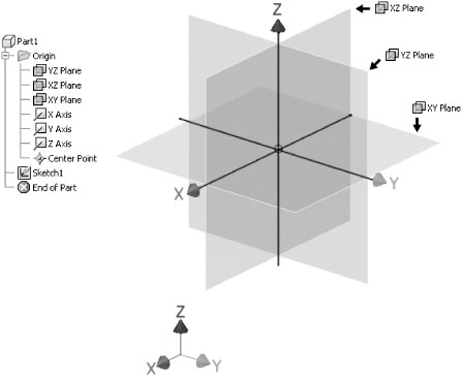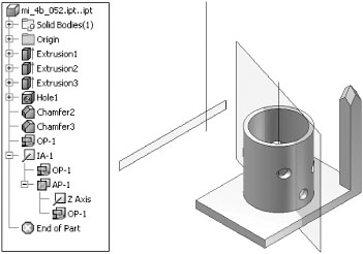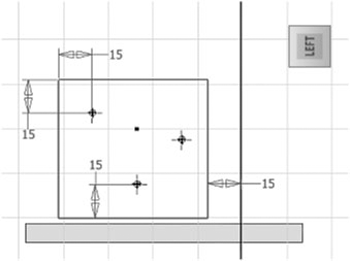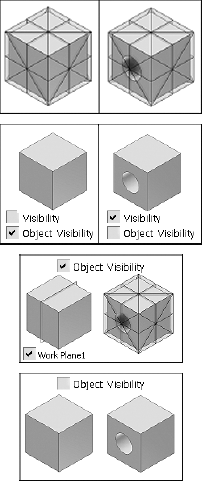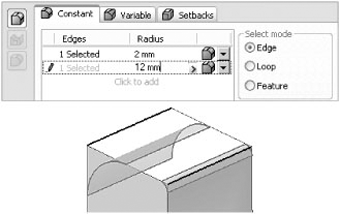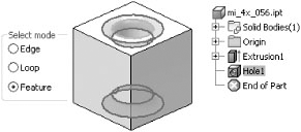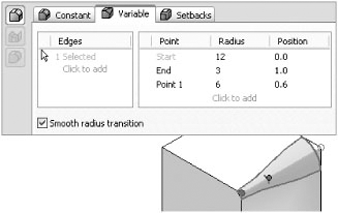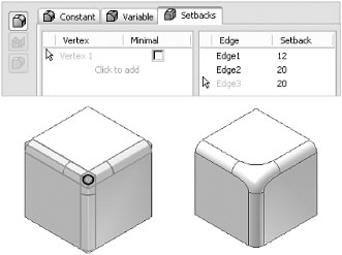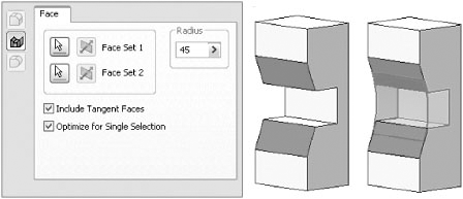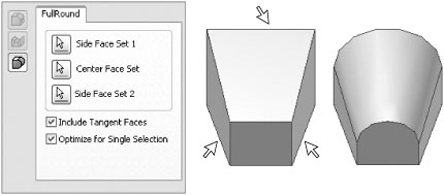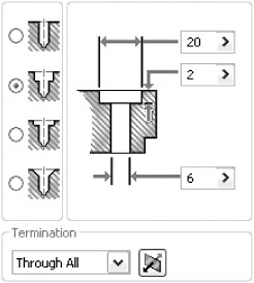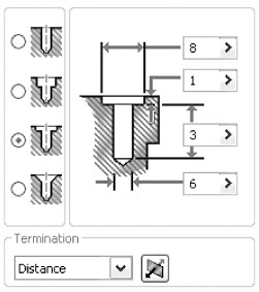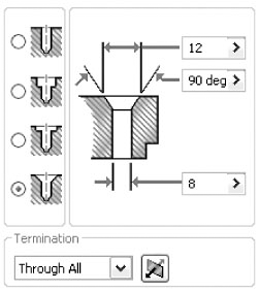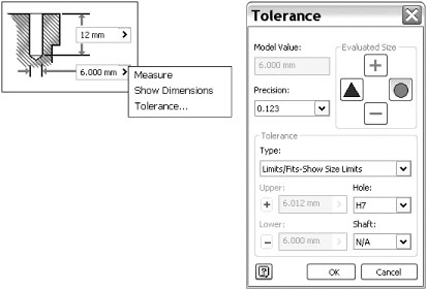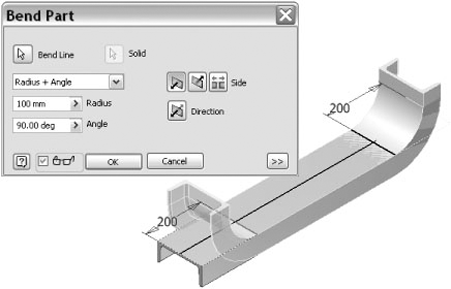This chapter covers the principles of creating a 3D parametric part, which makes it one of the most important chapters in this book. You'll start by looking at the general options and settings associated with Inventor and part files and then move on to a basic exercise exploring the fundamentals of creating parametric models. Then you'll take a deeper look at the options and tools found in the primary feature tools.
All the skills in this chapter are primarily based around creating a single part, whether it be in a single-part file or in the context of an assembly file. Do yourself a favor and learn or review these basics before jumping into the more complex features.
In this chapter, you'll learn to:
Set application options and settings for part modeling
Create basic part features
Use the Extrude tool
Create revolve parts and thread features
Create work features
Use the Fillet tool
Create intelligent hole features
Bend parts
As in previous chapters, you should make sure that your settings in Application Options match the approach we're using in this book. This will ensure that the examples you work on will match the results you see here.
You maintain global settings for Autodesk Inventor within the Application Options dialog box. For this section of the chapter, we will be concentrating on the Part tab in Application Options, which allows you to maintain part-specific settings. You can adjust the application settings as follows:
On the Tools tab, click Application Options.
Then choose the Part tab, as shown in Figure 4.1.
The Sketch On New Part Creation section allows you to predetermine in which origin plane the first sketch will be placed. If No New Sketch is selected, then Inventor will create a new part file without an initial sketch. You can then determine the origin plane for the first sketch.
The Construction setting determines whether created surfaces will be translucent by default or opaque like parts are.
The Auto-hide In-line Work Features option allows automatic hiding of a work feature when it is consumed by another work feature. For instance, if you create a work plane by clicking a work axis and a work point, the work axis and work point will be stacked under the work plane in the browser. The Auto-consume Work Features And Surface Features option allows Inventor to consume surfaces when converted to a solid, in addition to consuming work features.
The 3D Grips settings affect how 3D grips can modify a part file. In normal use, 3D grips allow you to modify part features by selecting and dragging a grip. If a dimension is controlling the feature, then the dimension will update to reflect the changes in the part. If Never Relax is selected, then any features controlled by the dimension will not change.
When Relax If No Equation is selected, then a dimension value will update, unless that dimension value is determined by an equation. Selecting Always Relax will always allow the use of 3D grips, even when controlled by an equation. The Prompt setting will prompt you to accept any changes during drag operations.
The settings in the Geometric Constraints area control how constraints will be handled during drag operations. Leave the Never Break option selected.
To change the options in a specific part file, you'll need to access the part's Document Settings dialog box by going to the Tools tab and clicking Document Settings while that part is open. The Document Settings dialog box that opens allows specific settings for an individual file in the following areas:
Lighting styles
Materials
Units
Modeling dimension display values
Individual sketch settings
Model values
Bill of materials (BOM)
Default tolerances
Any changes made in the part's Document Settings dialog box will be applied only to the current document. Current document settings will not affect the settings in other parts within the assembly.
Figure 4.2 shows the part's Document Settings dialog box with the Standard tab active. The Standard tab controls the active lighting style of the current graphics window. In addition, you can set the physical material properties of the current part here.
You can set the input measurement units on the Units tab, as shown in Figure 4.3. Internally, Inventor stores and calculates all values as centimeters. The settings on this tab allow you to change the unit specification values. As an example, you could open a metric (mm) part and change the input settings to inches.
On this tab, you can define the model dimension's display precision by the number of decimal places and define how that dimension will be displayed. Many people prefer the Display As Expression setting because it shows the dimension name along with any expression that exists in the dimension; if no expression exists, then the dimension name and dimension value are displayed. The Default Parameter Input Display setting allows you to see the parameter name in the input box when editing a dimension or feature input. Figure 4.4 shows the difference between the two settings.
On the Sketch tab, shown in Figure 4.5, you can adjust how the 2D sketch tools work and appear in an active sketch. In addition, you can change the preset value for Auto-Bend Radius in the 3D Sketch area.
Figure 4.6 shows the Modeling tab, which allows changes to the behavior while modeling the current active part.
Here are the settings found on the Modeling tab of the Document Settings dialog box:
- Adaptivity Used In Assembly
This is available only when a part is adaptive. When deselected, an adaptive part becomes static. This setting can be controlled by right-clicking an adaptive part in the assembly browser also.
- Compact Model History
This allows Inventor to purge all rollback document history when you save the current file. Compacting the model history improves performance in large assembly files. You should select this option only when performance is affected in large assembly files or when existing disk space is limited. Otherwise, leave this deselected.
- Advanced Feature Validation
This permits Inventor to use a different algorithm to compute features. Using this option can produce more accurate feature results in rare cases such as Shell, Draft, Thicken, and Offset features. However, this option is slower in calculation than the default option and should be used only on rare occasions where the accuracy of the model may be in question.
- Maintain Enhanced Graphics Detail
This enables graphics information to be saved with the file on disk. This information is used in the graphics display if the display quality is set to Smoother in Application Options.
- Tapped Hole Diameter
This determines how the size of tapped hole features are controlled. Thread representations in drawings are generated correctly only when Tapped Hole Diameter is set to Minor.
- Make Components Dialog
Clicking Options in the Make Components Dialog area opens the Make Components Options dialog box. The Make Component settings shown in the options dialog box are specific to the active project. These options are employed when creating multibody parts, as described in Chapter 5.
- Naming Prefixing
This sets the default file naming for parts generated from multibody part designs. Again, these tools are covered in Chapter 5.
- 3D Snap Spacing
These values are also set on the Modeling tab. These values have significance only when using 3D Snap.
- User Coordinate System
Click the Settings button to open the UCS Settings dialog box where you can set the UCS naming prefix, define the default plane, and select the visibility of UCs and its features.
- Participate In Assembly And Drawing Sections
This controls whether the part is sectioned in the assembly and drawing environments. This box is typically deselected in standards fastener parts that would normally not be sectioned according to traditional drafting standards.
The Bill Of Materials tab determines the structure of the current file and how that structure relates to the bill of materials in an Inventor assembly. Figure 4.7 shows the default settings for structure and quantity.
You can add BOM structure properties to individual parts in the Document Settings dialog box. Figure 4.7 shows the choices available in a model or assembly file for setting individual file properties. Here are the details:
- Normal
These components are given an item number and included in quantity calculations. The placement of normal parts in the bill of materials is determined by the parent assembly properties. A normal subassembly may be composed of any combination of inseparable, phantom, purchased, and reference parts without having any effect on how those parts are listed in the BOM. Normal is used for most components.
- Inseparable
These components are assemblies that allow the inclusion of press-fit, glued, welded, or riveted components that might be damaged if taken apart. A good example is a hinge that is fully assembled but should be listed in the BOM as a single part. Although the Inseparable structure is listed in the part's Document Settings dialog box, it is intended as an assembly property.
- Purchased
These components are parts that are not normally fabricated or manufactured by your company but instead purchased from vendors. Any purchased component, whether part or assembly, will be listed in a parts-only parts list. A purchased component assembly will not normally have the component parts listed in the BOM, since that component will be purchased as a single unit.
- Phantom
These components exist in the design but are not included as specific line items in the BOM. A construction assembly that exists as a container (subassembly) within a higher-level assembly, simply to hold a number of components together for assembly purposes, can be set to Phantom. When this assembly is set to Phantom, it will not appear in the parts list; however, the parts included within the construction assembly will be listed as individual parts. Phantom components are ignored by the BOM. No item number is assigned, and no quantity calculations are performed on the phantom assembly. However, the quantity of individual parts contained within the phantom assembly will be multiplied by the quantity of the phantom component included in the top-level assembly.
- Reference
These components are used to provide reference information within an assembly design. An example of a reference part might be a product container placed in a conveyor assembly. The conveyor components are the parts and assemblies you are designing, but the container is required to ensure the clearance and function of your design. In a drawing, reference parts will be indicated in the view as hidden line geometry. Reference components are excluded from the BOM and are excluded from quantity, mass, and value calculations.
Figure 4.8 shows the Default Tolerance settings. Creating tolerance values affects sketches and parts only. Adding tolerance values to a part file requires that you select either Use Standard Tolerancing Values or Export Standard Tolerance Values, or you can select both options.
You can select the Use Standard Tolerancing Values box to use the precision and tolerance values set in this dialog box. You can select the Export Standard Tolerance Values box to export tolerance dimensions to the drawing environment.
Once you've selected an option, you can then add linear or angular tolerance values. You can add any number of tolerance values by precision to this part. When you have added your values to the part, click Apply to stay in the dialog box and apply the new settings to this tab, or click OK to apply the settings and exit the dialog box.
Inventor 3D part modeling is based upon the principle of creating a base feature and then adding features to the base feature to build a more complex part. Figure 4.9 illustrates the basic workflow for creating a part composed of multiple features.
As you create parts in Inventor, you should keep in mind the following concepts because each will go a long way toward making your modeling endeavors more productive:
Anchor and orient your base sketch to the 0,0,0 origins of the part file. This will make your parts much easier to manage as you go forward. The base feature will generally be the largest feature in the part, unless there is a specific reason for not making it so.
Look for areas of your design that are likely to change, and create your part features to accommodate these future edits. As an example, the plate thickness of a support might likely change as loads are determined throughout the rest of the design. Creating the plate sketch from the end view and then extruding the length would make it easy to modify the length of the plate but not as easy to modify the thickness. Therefore, a better choice would be to create the base sketch of the top view and extrude the thickness.
Identify relationships between design parameters. For instance, the distance from the edge of a part to the edge of a bolt hole might be required to be always 2× the diameter of that hole.
Keep an eye out for patterned and symmetrical design features. It is much easier to create and modify the first instance of a pattern than it is to edit several identical features that were created separately.
Build logical feature dependencies. Features are dependent upon other part geometry when you cannot delete or modify a portion of the part or feature without affecting another feature built later in the part. As an example, if you were to create a simple block and then create an additional feature on that block, then you could not delete the block without upsetting the new feature.
Reserve fillets and chamfers for the end of the part as much as possible. Because these features often change, it is best to place them at the end of the design process. Placing them at the beginning of the design and then having to change them is likely to upset other features that you have created afterward that might depend on the filleted or chamfered edges.
Create simple sketches to create simple features to create complex parts. Using numerous features within a 3D model allows simplified control over modifications of the model in the future. Separate features may be suppressed or modified to alter the design, without having to make changes in a complicated sketch. Instead of attempting to create all the geometry in a single sketch, we'll analyze the proposed part first.
One good method for determining how parts should be created in Inventor is to mimic the steps required to machine such a part. Consider how the part shown in Figure 4.10 would be created in the real world.
In the shop, you would first cut a rectangular plate to the proper size. Then you would probably machine the slot and the chamfers at the end. Once that was completed, you would likely mill the face of the part to create the triangular pocket and the extending lip around the pocket. And finally, you would create the threaded holes on the face and finish with the threaded holes in the chamfers.
There is probably no concept that will help you master creating parts in Inventor that is more important than the idea of creating simple sketches from which to build simple features that will add up to create complex parts. Standard 2D drafting practice requires that you place all part details or components within a single view. However, it is not good practice to use the same 2D drafting workflow within any feature-based 3D modeler. Complicated sketches can drag down sketching performance and virtually eliminate easy changes to features. Consider the part shown in Figure 4.11. On the right is the part created from a single complex sketch; on the left is the same part created from a simple base sketch and then several dependant features.
The version on the right would prove difficult to modify, while the one on the left would be a snap because each feature is broken out into its own sketch and/or feature. Of course, sometimes creating a more complex sketch is required, but if you follow the simple sketch rule of thumb, you will find Inventor much more accommodating, and you will quickly master part creation and be ready to tackle complex sketches when they are needed.
In the pages to follow, you will create a part similar to the part shown in Figure 4.11. To do so, you'll begin by creating a new part file from the Standard(mm).ipt template:
On the Metric tab of the New File dialog box, select the
Standard(mm).ipttemplate.On the Sketch tab, click the Rectangle button, and place the rectangle so that origin point is to the inside.
On the Sketch tab, click the Line tool, and sketch a diagonal line from corner to corner of the rectangle.
Next select the diagonal line, and then click the Construction button in the Format panel on the Sketch tab (toward the far right). This converts the diagonal line from a standard line to a construction line so that Inventor will ignore it as a profile entity. Your line should now be dashed and will have changed colors.
In the Constrain panel of the Sketch tab, click the Coincident button, and place a coincident constraint between the midpoint of the diagonal line and the origin point.
Use the Dimension tool found on the Sketch tab to dimension the sketch at 150mm by 300mm as shown in Figure 4.12.
Right-click and choose Finish Sketch, and then click the Extrude command on the Model tab.
Click the corner of the ViewCube to find an isometric view of the sketch so that you can see the preview (if it's not displayed, go to the View tab, go to the Windows panel, click the User Interface button, and click the drop-down arrow).
Generally Inventor will select the profile for you if you have just one closed profile present to extrude. If the profile is not selected, click anywhere in the rectangle to select it. If you did not make the diagonal a construction line, you will need to select both triangular halves of the rectangle.
Enter 25mm in the Distance input box. Click the arrow buttons to change the extrude direction just to see how the preview updates. Then click the left arrow button, and click OK.
Now that you've created your base feature, you will continue by adding features to it. Before doing so, it is a good idea to save your part. To do so, click the Save icon from the Quick Access bar at the top of the screen, or click the Inventor button and then select Save. You can save the file in the Chapter 4 folder and name it anything you like.
Now that the part is saved, it's time to create a second feature:
On the Model tab, click the Create 2D Sketch button, and then click the large front face of the part (or right-click the face and select New Sketch). Sketch2 is now created and active.
Use the ViewCube to orient your view of the part so that you have a flat 2D view of your sketch plane with the rectangle running horizontally on your screen.
If you see sketch lines outlining the base feature, then you have the option to have auto project faces turned on. If you do not see those sketch lines, select the Project Geometry tool on the Sketch tab, and select the face again to project the edges.
Sketch a rectangle on the face selected for the sketch. Place this rectangle in the middle of the face, being careful not to accidentally constrain it to the origin point or the edge of the base feature (you will relocate it using a sketch constraint later).
Select the Circle tool on the Sketch tab, and sketch a circle at the end of the rectangle starting with the midpoint of the vertical line on the right and snapping to the endpoint of the top or bottom line. You don't need to trim the circle before converting this sketch into a feature, and in fact, unneeded trimming of sketch entities often works against you because it may remove sketch constraints.
Use the Dimension tool on the Sketch tab, and add a dimension to the circle. Rather than just entering a value, enter Diameter = 40mm, thereby assigning the dimension a name and a value (be sure you have named this dimension, as you will be using it in the steps to come).
You'll next create an equation for the length of the rectangle based on the length of the diameter value. With the Dimension tool, select the edge of the rectangle, and enter Slot_Length=.
Then click the 40mm diameter dimension you just created. This will link the two dimensions. Finish the equation with *5 so that your end equation reads Slot_Length = Diameter*5. Note that you must use an underscore here because spaces are not allowed in parameter names. Your sketch should look similar to Figure 4.13.
Create a coincident constraint between the midpoint of the left vertical line of the rectangle and the midpoint of the left, projected, vertical line of the base feature.
Select one (or all) of the projected lines of the base feature, and convert it to a construction line (this ensures that Inventor will not attempt to extrude the large projected profile in the next step).
Finish the sketch, and choose Extrude on the Model tab.
Use the ViewCube to view the part from an isometric view.
Select the rectangle and the circle you just created for the profile.
Click the Cut button (the second button down in the list of operation buttons) so that the profiles will be cut out of the base feature. Your preview should be red when the Cut operation is selected. Check the direction arrow to ensure that the cut is going in the right direction.
In the Extents drop-down, select All. The All option extrudes the profile through all the current features of the entire part in the specified direction or in both directions if you chose the Midplane option. If the size of the base part features change, then the cut extrusion feature will update accordingly. Click OK when your options look like Figure 4.14. And then save your file.
Hole features are very powerful components of Inventor. Many methods are available for creating Hole features. You can create holes in the following ways:
By utilizing existing sketches containing sketch center points
By distance from two planar edges
On a face by referencing concentric edge
By using a work point feature
Follow these steps to create another sketch, and then use that sketch to place a hole:
On the Model tab, click the Create 2D Sketch button, and then click the large front face of the part (or right-click the face and select New Sketch). Sketch3 is now created and active.
Use the ViewCube to orient your view of the part so that you have a flat 2D view of your sketch plane with the rectangle running horizontally on your screen.
You should see the outline of the sketch plane face automatically projected into your sketch (if not, click the Project Geometry button, and select the sketch plane).
On the Sketch tab, select the Offset button found on the Modify panel.
Before selecting anything offset, right-click and ensure that both the Loop-Select and Constrain Offset options are selected.
Click the radius, and then drag the offset profile so that it is created to the inside of the part. Then right-click and click Done.
Place a dimension between the offset profile and the outside edge of the part, and enter Offset = 20mm in the input box (again, be sure and name this, because you will be using this in the steps to follow).
Window-select the entire part/sketch so that all of the lines are selected, and then click the Construction button and convert the lines to construction lines.
Select the Point tool on the Draw panel of the Sketch tab, and place a point on the corner of the offset loop as shown in Figure 4.15.
Finish the sketch, and choose Hole on the Model tab.
Use the ViewCube to view the part from an isometric view.
The Hole tool should have automatically selected your sketch point; if not, ensure the Placement drop-down is set to From Sketch and the Centers button is selected, and then select the sketch point on-screen.
In the Termination drop-down, select Through All to ensure that the hole depth always cuts through the part. Then set Type to Tapped, set the Threads options to ISO Metric Profile M10x1.5 (as shown in Figure 4.16), and then click OK; finally, save your part.
So far, the features you've created have been based on a sketch. These types of features are therefore referred to as sketched features. Features not based on sketches are referred to as placed features. Placed features are solely dependent upon existing part geometry. Later in this section, we will discuss the steps necessary to create a placed feature in the form of a rectangular pattern.
When creating patterns, you have the choice of creating them at the feature level or at the sketch level. For instance, you could have patterned the sketch point using a sketch pattern and then have placed multiple holes at once using the Hole tool. It is generally best, though, to create patterns as features rather than sketch patterns. There are two reasons to consider feature patterns:
A pattern saves time when creating spaced, multiple instances of a feature, and it makes editing the spacing easily accessible.
Using a pattern in a part allows you to later use that pattern to create a component pattern in an assembly and follow the original part pattern. For instance, if you placed this part into an assembly, you could pattern a bolt to occupy every hole within the pattern by simply constraining one bolt into the original hole feature and then use the Component Pattern tool to automatically pick up the hole pattern count and spacing. The Component Pattern tool is available only within the assembly environment.
Let's determine the pattern spacing first. From the creation of the second feature, you know that the round and slot has a width of 40mm. From the creation of the placed hole, you know that the offset from the slot edge is 20mm. From this information, you will determine that the spacing of the two rows of holes are (2 × offset value) + 40mm, or 80mm. The design specification shows eight holes in each row, and we'll decide now that they need to be spaced at a distance of 25mm apart. With this information, you are now ready to proceed with creating the hole pattern:
On the Model tab, click the Rectangular Pattern button.
In the Rectangular Pattern dialog box, you are being asked to select the features to pattern. You can select the hole from the graphics area, but may find it easier to do so from the Model browser. No matter the method you use, check the Model browser to ensure that Hole1 and only Hole1 is highlighted (you can use Ctrl+click to deselect any accidentally selected features).
Next, click the arrow button under Direction 1, and select the edge of the slot cutout. Use a direction button to change the direction if required, and set the count and spacing to 8 and 25mm, respectively. You can confirm that your settings look like Figure 4.17.
Next, click the arrow button under Direction 2, and select one of the short ends of the part. Use a direction button to change the direction if required, and set the count to 2.
Although you could just change the Row Spacing value to 80mm and complete the pattern, you might want to consider what would happen if the width of the slot feature were to change. If that were to happen, then the hole pattern spacing would stay at 80mm and no longer remain symmetric to the slot width. To avoid this, you will make the pattern Row Spacing parametric by calling the dimensions of earlier features into your pattern spacing and building a formula right into the pattern so that if those dimensions change, the Row Spacing setting will follow.
To do this, first clear the Row Spacing input box.
Next click the arrow at the right of the Row Spacing box, and click List Parameters from the flyout shown in Figure 4.17.
Choose Diameter from the list, then choose List Parameters again, and finally choose Offset.
Edit the input to read Diameter + 2* Offset, making sure you include the parentheses.
If the text shows in red, there is an error. When you have a valid formula, it will be in black. Check the preview, ensure that the pattern looks correct, and then click OK. Confirm that your part looks like Figure 4.18.
You will often need to modify a sketch and/or feature after you have created it. Oftentimes you may find that because designs are similar, it is most efficient to copy an existing part and then make changes to the copy.
In the next steps, you'll edit some of the features you've just created, but before doing so, it will be helpful understand the behaviors associated with the model tree and browser nodes. When a feature is sketch based, you can expand the plus sign next to it to reveal the sketch. Likewise, when a feature has multiple elements such as a pattern, you can expand it to view and control each element. If a feature is placed rather than sketch based, it may not have any elements and therefore will lack a plus sign. Figure 4.19 shows the anatomy of the three browser nodes.
The extrusion is based on a sketch, as you can see. However, the hole in Figure 4.19 is a placed feature based solely on the edges of other features and therefore contains no sketch (you'll place a hole of this type in the pages to come). The pattern, when expanded, shows both the features that it contains and each occurrence of those features.
To edit a feature or a sketch, you can right-click it and choose Edit Feature or Edit Sketch, or you can double-click the browser node icon for that feature/sketch. Be sure to double-click the node icon rather than the node text; otherwise, you set the text active for renaming. Follow these steps to explore the edit procedures of features and sketches:
On the Get Started tab, choose Open (or press Ctrl+O on the keyboard).
Browse for the file named
mi_4a_004.iptlocated in the Chapter 4 directory of the Mastering Inventor 2010 folder, and click Open.In the Model browser, right-click Extrusion2, and choose Edit Sketch. You'll notice that the sketch becomes active for edits and the part displays in a rolled-back stage as it existed when the sketch was originally created.
You want to edit the diameter dimension and change it to an inch-based value. To do so, double-click the dimension, type 2 in into the input box, and then press Enter.
You'll notice that Inventor converts the value to a millimeter equivalent for you. You can mix units as required, but know that any value that does not have a unit is assumed to be the part's base unit. This means if you were to enter 2 without the "in" suffix, the diameter would be set to 2mm, because this part is mm based.
Click the Finish Sketch button on the Sketch tab (or right-click and click Finish Edit) to return to the feature level of the part.
You'll also notice that as a result of the sketch edit of the diameter, the length of the slot cutout adjusts automatically as well, because it contains a formula to ensure that it is always 5× the diameter of the circle.
Note that the spacing for the rectangular pattern adjusted automatically on each side of the slot cutout but did not adjust for the length of the pattern. This is because the pattern contains a parametric formula that controls the width spacing but not the length. To fix this, you'll edit the rectangular pattern, as shown in these steps:
Double-click Rectangular Pattern1 in the browser to open the edit dialog box.
On the left side, clear the value of 25mm, click the arrow button, choose List Parameters from the flyout, and select Slot_Length from the list.
The spacing is now adjusted so that the holes are patterned at the Slot_Length value, and obviously this is not correct. To fix this, click the drop-down at the bottom left, and change it from Spacing to Distance. Click OK to accept these changes.
You may decide that the rectangular pattern needs to include features that were not originally present when the pattern was created, such as Extrusion3 and Chamfer1 found in this part. If you edit the pattern, you'll notice that the part rolls back to the state that existed at the time of the pattern; therefore, you cannot add the new features to the pattern. To resolve, this you will reorder the features and then edit the pattern.
In the Model browser, select Extrusion3 and Chamfer1, and drag them above the rectangular pattern. You can reorder features in this way so long as they are not dependent upon one another. For instance, if you attempt to drag Chamfer1 above Extrusion3, you'll find that it can't be done. This is because the chamfer is based on the geometry of the extrusion.
Once the features have been reordered, double-click the rectangular pattern to edit it, or right-click and choose Edit Feature.
Click the Features button, and select Extrusion3 and Chamfer1 from the Model browser so that they are added to the pattern. Your preview should update as well. Click OK to accept these changes.
You may decide that although the pattern provides the correct spacing of the elements, you need to exclude some of the middle instances to accommodate other features. You can do this easily by suppressing the instances that you do not need, which maintains the constant pattern spacing.
Expand the rectangular pattern feature in the browser, and note that all the instances of the patterned features are listed as occurrences.
Roll your mouse pointer down over the list, and you will see the instances highlight on-screen indicating which occurrence they are.
Identify the fourth and fifth instances on each side of the pattern, right-click them, and choose Suppress. You can do this one at time or hold Ctrl as you select them and suppress them all at once. Notice that these occurrences are no longer present on the part and are marked with strikethrough in the browser. Figure 4.20 shows the results of these edits.
Ordinarily, you want to create chamfer and fillet features at the end of the overall part creation process. Creating chamfers and fillets at the end of the process reduces errors because of feature dependencies associated with these features. In the following exercise, however, you will create a chamfer before creating a hole and then make a change to illustrate both the folly of creating placed features too early in the design and the method of repairing a feature error:
On the Get Started tab, choose Open (or press Ctrl+O on the keyboard).
Browse for the file named
mi_4a_007.iptlocated in the Chapter 4 directory of the Mastering Inventor 2010 folder, and click Open.Select the Chamfer command on the Model tab, and select the corner indicated with the red arrow.
Set the distance to 30mm, and click OK.
Next click the Create 2D Sketch button to create a sketch on the yellow face.
Use the Point tool to place a point near the chamfered corner, dimension it as shown in Figure 4.21, and then click Finish Sketch.
Select the Hole tool on the Model tab, and place a counterbore hole as shown in Figure 4.21.
Next it is decided that the chamfered corner will not work with this design and should have been a filleted corner. To make this change, right-click the chamfer feature in the Model browser, and choose Delete from the menu.
Because the counterbore hole is dependent upon the chamfer, you are prompted with the option to keep it or let it be deleted also. You will choose to keep it by deselecting the Dependant Sketches And Features box and clicking OK.
Notice the Hole feature in the browser now has a marker symbol next to it indicating that this feature is "sick" and is in need of some repair. Expand the feature node, and you will see that the sketch is also marked as "sick." Right-click the sketch, and choose Recover, as shown in Figure 4.22.
In the Sketch Doctor dialog box, you will see a list of the issues that are present in the problematic sketch. Click Next to see the recommendations for resolving this problem.
Click Next again, and you will see that there are treatment options in this case. Depending upon the extent of the error, the Sketch Doctor may offer you the ability to delete objects, close open loops, and so on. In this case, you will just click Finish and then click OK in the message box that informs you that you are being taken to the sketch environment. Of course, you could have just edited the sketch originally and ended up with the same result, in this case. But in cases where you do not know the extent of the problems, the Recover option may be helpful.
In the sketch, you will see the unresolved sketch entities highlighted in a magenta color. Right-click the magenta line, and choose Break Link. This breaks the link with the missing chamfer edge but does not fully fix the problem.
Select the magenta endpoints, and use the Break Link option on them as well. This results in the diagonal line being underconstrained. You have two choices to resolve this:
Use the coincident constraint along with the general dimension line to lock down the diagonal line.
Delete the diagonal line and its referencing dimensions, and redimension the hole center point off the edge of the base part.
Once you have reconstrained the hole center by one of these methods, click Finish Sketch, and return to the feature level of the part. Notice that the hole and sketch are now no longer "sick."
Choose Fillet on the Model tab, and select the same edge previously used by the chamfer to place a 30mm fillet.
Although there is probably no way you will ever completely avoid having to repair features and sketches, using placed features such as chamfers and fillets as late in the design as possible will go a long way toward reducing these issues. You should also strive to avoid referencing these features with dimensions when they are present.
Although you have explored the basics of creating extrude features, you have many options to understand before you can truly master this simple but powerful tool. In the next several pages, you will open a series of files that have been set up to demonstrate the various options to you. You can find all of these files in the Chapter 4 directory of the Mastering Inventor 2010 folder.
You can use the Extrude tool's Cut option to remove material from your parts. Although you may think of this as a tool to create holes, keep in mind that Inventor's Hole tool is the better choice to create standard holes because of the advanced detailing functions that accompany the Hole tool. With that said, the Cut option in the Extrude tool will allow you to cut material using any sketched profile that you might come up with.
Open the file named
mi_4a_010.ipt.Click Extrude on the Model tab.
Select the rectangle shape for the extrude profile, and set the distance to 20mm.
Choose the Cut option; notice that the preview turns red, and the direction automatically switches. Change the direction so that the preview is going up out of the part, and then click OK.
Note that an error is generated, and it states that the feature you specified did not change the number of faces. Keep this in mind as you use the Extrude tool. Inventor will generally set the correct direction for you, but occasionally you might need to set the direction manually. Click Edit to return to the extrude options.
Change the direction again so that you are indeed cutting the part, and then click the More tab as shown in Figure 4.23.
Enter −12 in the Taper input box, and click OK.
You can create complex shapes by sketching the two separate side profiles and then use the extrude Intersect option to keep the combined volume of the two, as shown here:
Open the file named
mi_4a_012.ipt.Select the visible shape for the extrude profile.
Change the Extents drop-down from Distance to All.
Click the Intersect button, and ensure the extrude direction is correct (or use the midplane option to extrude both directions).
Check your settings against Figure 4.24 and then click OK, and you will see that only the volume shared between the existing solid and the intersect profile are kept.
In addition to creating solids with the Extrude tool, you can also create surfaces. If the profile is open and there is no other geometry to relate to, the surface solution is automatically selected. For closed profiles, you are required to switch the output from solid to surface manually, as shown here:
Open the file named
mi_4a_014.ipt.Select Extrude on the Model tab.
The visible shape will automatically be selected because it is the only available profile. Because it is found to be an open profile, the Surface output is automatically selected.
Change the distance to 25mm, and set the direction arrow to the midplane option so that the surface is extruded out in both directions from the profile. And then click OK.
To explore how to create a surface extrusion from a closed profile, right-click Sketch2 in the browser, and turn on the visibility.
Select the Extrude tool, and notice that Inventor automatically selects the profile and sets the output to Solid.
Click the Surface button, and then change the Extents option to To.
This allows you to specify a point or surface to extrude to. You might notice that the surface created in the previous step created in two halves. Select the spline-shaped half, and then click OK. Your result should be two surfaces as shown in Figure 4.25.
In addition to extruding surfaces from open profiles, you can extrude solids, provided sufficient geometry is present to allow the open profile to solve correctly. This technique employs the Match Shape option and is the default solution when an open profile is selected in the Extrude tool while the solid output is selected. To do this, follow these steps:
Open the file named
mi_4a_016.ipt.Select Extrude on the Model tab.
Click the arc profile, and notice that the Match Shape check box is automatically selected; in addition, the arc has been extended down toward the plate to provide a close profile.
Click in the highlighted profile to select it.
Change the Extents drop-down to 60mm, and click OK. Your result should look like Figure 4.26.
To take a look at the Match Shape option and how it can be used to change the output, you'll open a file that has two possible solutions for the final matched shape. One solution will match the shape of the existing geometry, and the other will not. Follow these steps to see how this works:
Open the file named
mi_4a_018.ipt.Select Extrude on the Model tab.
Click the visible profile sketch in the center of the part.
You'll notice that Inventor attempts to create a closed profile from this open profile by extending the profile past the extents of the existing geometry. Select the profile on the side with the grid feature.
Change the Extents drop-down to Distance, enter 1mm, and click OK. Notice how the extrusion fills the shape of the part.
Next edit the extrusion, and deselect the Match Shape box. And then click OK.
You'll notice that the extrusion runs through the grid feature ignoring the shape.
Figure 4.27 compares the results of an open profile extrusion with and without the Match Shape option selected.
It is often helpful to extrude to existing geometry rather than entering a distance value. In this way, if the existing feature changes, so too will your extrusion, and you can extrude to faces and vertices as well as work planes and work points, as shown here:
Open the file named
mi_4a_020.ipt.Select Extrude on the Model tab.
Change the Extents drop-down from Distance to To.
Select the yellow face, and click OK. You will receive an error stating that the termination plane does not completely terminate the profile. Click Edit to return to the Extrude dialog box.
Uncheck the Terminate Feature On Extended Face check box in the Extents area, as shown in Figure 4.28, and then click OK.
You can try it again, this time selecting the red face, and you will see that using the To option produces the same result in both cases.
Follow these steps to take a look at some other Extrude To options:
Open the file named
mi_4a_022.ipt.Select Extrude on the Model tab.
For the profile, select one of the ellipse-shaped profiles.
Change the Extents drop-down from Distance to To, and ensure that the Terminate Feature On Extended Face check box is checked. In this case, you would receive an error if this check box were not selected.
Select the yellow face, and click OK. You'll see that the ellipse face takes on the angle of the face to which you extruded.
Select the other ellipse profile, and change the Extents drop-down from Distance to To, once again. This time select the work point for the terminating object, and click OK.
You'll see that the ellipse extrudes up to the work point height as shown in Figure 4.29.
Oftentimes when extruding to a cylindrical face, you will need to set the extrude to solve for the minimum solution since the face is continuous all the way around. To do this, follow these steps:
Open the file named
mi_4a_024.ipt.Select Extrude on the Model tab.
For the profile, select the hex-shaped profile.
Change the Extents drop-down from Distance to To, select the outside face of the pipe, and then click OK.
You will notice that the hex shape continues through the pipe to the farthest extent of the cylindrical face. To fix this, edit the extrusion you just created, and click the More tab.
On the More tab, select the Minimum Solution check box as shown in Figure 4.30, and then click OK.
Similar to extruding to a selected entity, you can use the To Next option and let Inventor automatically select the next available surface or face for you. It should be noted that solutions with through voids may not work with this option.
Open the file named
mi_4a_026.ipt.Select Extrude on the Model tab.
For the profile, select the rectangular profile marked Profile1.
Change the Extents drop-down from Distance to To Next, and click OK.
Repeat the same steps for Profile2. You will receive an error because the extrusion cannot build to this solution.
In the error message dialog box, click OK, and then set the extrude extents to To.
Select the back (yellow) face for the face to extrude to, and then click OK. Oftentimes the geometry may require a bit of experimenting to get the solution you want. Just knowing the abilities and limitations of each option goes a long way toward knowing how to proceed.
Figure 4.31 shows the results of using the To Next extent option.
You may need to define the beginning and the end of an extrusion that are not common to your sketch plane. To do this, you can use the From To option:
Open the file named
mi_4a_028.ipt.Select Extrude on the Model tab.
For the profile, select Circle.
Change the Extents drop-down from Distance to From To, and click OK.
Select both pipe-shaped pieces to define the From and To options.
Because you are extruding to hollow objects, you'll need to use the minimum solution option. Click the More tab, and select the Minimum Solution check box.
Then flip the direction using a direction button. Your preview will disappear, but the feature will build. Click OK.
Figure 4.32 shows the results of using the From To extent option.
You may have noticed a couple of other buttons in the Extrude dialog box, one called Solids and the other called New Solid, as shown in Figure 4.33. These options allow you to create separate solid bodies within the part or choose which existing solid bodies to modify.
Follow these steps:
Open the file named
mi_4a_030.ipt.Select Extrude on the Model tab.
For the profile, select the rectangular sketch profile.
Change the Extents drop-down from Distance to To Next, and ensure that the direction is going down into the part.
Click the New Solid button to set this extrusion as a separate solid body.
Click the More tab, set the Taper to −12, and then click OK.
In the Model browser, expand the Solid Bodies node, and notice that you have two individual solids.
In the browser, right-click the sketch called Slug Sketch, and choose Visibility.
Once the sketch is visible, select Extrude on the Model tab.
Select the circle for the profile, and then set Distance to 2mm.
Click the Cut button so that you are cutting the circular shape, click the Solids button (the one under the Profile button), and then select both solid bodies. You can check the Solid Bodies folder in the browser to see that both are selected. Then click OK.
Choose Solid2 from the Solid Bodies folder in the browser, right-click, and choose Hide Others.
Rotate around or use the ViewCube to view the solid.
More information on the use of multibody solids will be covered in the next chapter. Figure 4.34 shows the two solid bodies pulled apart.
Creating turned and revolved parts is a regular occurrence in many engineering departments because of the types of parts designed and manufactured. The parts consist of circular features around a common axis. There are actually two different workflows for creating circular parts, each with its own advantages and disadvantages. Creating threads on a part presents another challenge.
You can create circular parts using a single sketch and revolving it around a centerline axis. Alternatively, you can create multiple circular extrusions to produce the same part.
There are also two different workflows for creating thread features on a part. You can add threaded features to any circular component by means of the thread feature, which creates cosmetic threads on the part, or through the use of the coil feature, which creates physical threads. Typically physical threads are created only when that geometry is required for the model. Generally, using cosmetic threads is sufficient because they are an intelligent feature that can be retrieved in the detail drawing of the part and called out as per the specifications of the feature.
Revolved cylindrical parts utilize a sketch with a center axis. Figure 4.35 illustrates two ways to create the same sketch. The view on the left shows a sketch profile anchored at the origin and dimensioned from the origin. The view on the right illustrates the same sketch, anchored at the origin but dimensioned from a created centerline, which creates diametric dimensions. The two sketches will create the same revolved feature, the difference being that the centerline allows you to dimension the sketch using diameter dimensions to maintain the design intent of the part.
The centerline is created with the use of the Line tool with the Centerline tool toggled on. In this example, the centerline was created starting at the origin point and continuing to the right of the sketch, extending beyond the sketch for selection ease. When dimensions are created on the sketch and terminated at the centerline object, they will actually extend to the other side of the revolved part diameter.
The advantage of creating a revolved profile, rather than creating stacked circular extrusions, is that the relationship of every portion of the sketch can be easily visualized from the start. The disadvantage is that a contour sketch is not always easily edited to remove or change a portion of the feature. In addition, if the sketch is not fully dimensioned and constrained, it can create errors down the line with faces and edges. For this reason, you should always fully dimension and constrain your sketches. Figure 4.36 shows the finished revolved feature.
An alternate method, using extruded circular features, provides better control and can allow for editing of each individual portion of the cylindrical part. Essentially, this is the building-block approach of creating one feature after another until the entire cylindrical part is created. Figure 4.37 shows the finished extruded feature.
The advantage to this approach is that the same part design is comprised of four separate features, each one individually editable without affecting other portions of the part.
The disadvantage with this approach is that it takes a small amount of additional time to create the part and create features that are dependent upon the previously created feature. If any extrusion in the middle of the part is deleted, then, prior to deletion, the next feature down the model tree will need to be reassociated with a different face.
Revolves can be parts or features and solids or surfaces. Follow these steps to see how revolves are created:
Open the file named
mi_4a_032.ipt.Select Revolve on the Model tab.
For the profile, select the rectangular sketch profile and the small circle.
Click the Axis button in the Revolve dialog box, and then select the line indicated on the part for the axis.
Set the operation to Cut so that you are milling out the revolved profile.
By default the Extents drop-down is set to Full, giving you a 360-degree revolve. In this part, though, a full revolve cut would cut away part of the existing feature. So, you will set the Extents drop-down to Angle instead. Notice the other extents options available. They should all look familiar as options from the Extrude tool.
Set the angle to 180, and then click OK. Figure 4.38 shows the revolve options.
Next you'll use the Revolve tool on an open profile to create a revolved surface. You'll then use a tool called Thicken to turn the surface into a solid.
Open the file named
mi_4a_034.ipt.Before creating the revolve feature, you need to supply the sketch with some missing dimensions. To do so, right-click Sketch1 in the browser, and choose Edit Sketch.
Place dimensions from the points shown in Figure 4.39 to the centerline, and you'll notice that because the line is a centerline type, the dimensions are automatically diameter dimensions. Before placing the dimension, you can right-click and choose Linear Dimension if a diameter is not the correct choice.
Once you've added the dimensions, click the Finish Sketch button, and click Revolve on the Model tab.
For the profile, select the sketch profile.
Click the Axis button, and then select the centerline.
Because the sketch was an open profile, the Surface output is automatically selected. Click OK to create the revolved surface.
Next you'll add some fillets. On the Model tab, click the Fillet button, and click the circular edges on the surface feature.
In the Fillet dialog box, change the radius to 12mm, and then click OK.
In the surface panel on the Model tab, click the Thicken/Offset button.
Click the Quilt option in the Thicken/Offset dialog box to allow you to select all the surface faces at once, and then click anywhere on the surface. Then click OK.
Rotate the part around or use the ViewCube, and you'll see that the surface is still visible. Locate it in the Model browser, and then right-click and turn its visibility off. Figure 4.40 shows the revolved shape.
Inventor offers the option of creating cosmetic threads that represent actual threads in the part, and it creates 2D geometry information for detailing those threads. Cosmetic threads are created with a threaded hole feature. Or you can use the Thread tool on the Feature panel bar to add threads to existing part features. The thread features are added to the Model browser as a separate feature.
Creating cosmetic threads on a circular part is a relatively simple procedure. Cosmetic threads work by wrapping a scaled graphic around the feature to represent threads. This allows the model file size to stay smaller because it is not required to calculate all of the extra edges and faces of the threads. However, the cosmetic Thread tool does create fully intelligent thread features based on the specifications you choose, allowing you to detail the threads quickly and accurately in the drawing environment.
In the following steps, you will use the Split tool to divide a cylindrical surface into multiple faces and then apply cosmetic threads to them:
Open the file named
mi_4a_036.ipt.Select the Split tool in the Modify panel on the Model tab.
Select Work Plane1 for the Split tool, select the face of the cylinder it runs through, and then click OK.
Right-click the edge of the Work Plane1, and choose Visibility to turn the plane off. Recall that work planes are selectable only by their edges.
Now that the part is divided into two faces, click the Thread button in the Modify panel, and select the shortest face.
Click the Specifications tab, set the size to 17, and the designation to M17x1, and then click Apply.
Switch back to the Location tab, and click the end of the middle cylinder.
Uncheck the Full Length check box, and enter 5mm for the Offset and 30mm for the Length. Click the direction button if you do not see the threads appear. Click Apply.
Run your mouse pointer over the third cylinder, and notice that as you get closer to one end or the other, the offset and direction switch.
Click the face, and apply another set of threads of any type you like; when you're done, click OK. Figure 4.41 shows the Thread tool options.
You can create physical threads using the Coil tool. Physical threads create large file sizes compared to cosmetic threads and can seriously affect performance and assemblies. As a result, physical threads should be used only where absolutely necessary, such as the design of a bottle or jar top or other geometries such as a worm gear.
Open the file named
mi_4a_038.ipt.In the Model browser, select the sketch called Thread Cut Sketch, right-click, and select Edit Sketch.
Right-click and choose Slice Graphics (or press F7 on the keyboard) to temporarily slice away the material that hinders your view of the sketch. Recall that this option is available only while creating or editing a sketch that runs through a solid.
Zoom in on the sketch, change the depth dimension to 2mm, and then click the Finish Edit button to exit the sketch.
Zoom out (or double-click the mouse wheel to zoom all), and then click the Coil tool in the Create panel on the Model tab.
Select the sketch profile if it does not automatically select, and then select the work axis in the center of the cylinder for the axis.
Use a direction button to ensure the coil is running the correct way, and then click the Cut button.
Click the Coil Size tab, change the pitch to 4mm and the revolution to 12, and then click OK.
Figure 4.42 shows the Coil Size tab. Be aware that you can create coils by specifying pitch and revolution, revolution and height, and pitch and height, or by defining a spiral. Also note the suffix of ul shown in the revolution dialog box. This suffix just means that the value is unitless. You do not have to specify this because Inventor will do so as needed.
Work features are construction geometry, used when part geometry is not present to create new features. There are three types of work features: work planes, work axes, and work points. In addition to work features that you might create, each part contains origin planes, axes, and an origin point. You can view these by expanding the Origin folder in the Model browser, right-clicking each feature, and selecting Visibility, as shown in Figure 4.43. Note that in this illustration the 3D indicator arrows have been drawn in for clarity. If it helps you, though, you can turn the indicator on and have it display in the lower left of your screen by going to the General tab of the Application Options dialog box.
A work plane is an infinite construction plane that is parametrically attached to a feature or features, typically to help you define other geometry. Work planes are created based on the geometry you select. Every work plane type is created by defining a location and an orientation. The following illustrations show the ways you can create work planes. You can open the corresponding part files and follow along. The part files are named mi_4a_040.ipt through mi_4a_50.ipt, as shown here.
- Bisecting two parallel planes
Two parallel planar faces or work planes (see
mi_4a_040.ipt).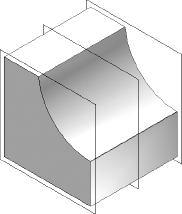
- 3 point
Any three endpoints, intersect points, midpoints, or work points (see
mi_4a_041.ipt).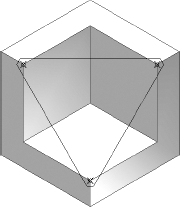
- Normal to axis through point
A linear edge or axis and a point, in either order (see
mi_4a_042.ipt).
- Parallel to plane through point
A planar face or work plane and any point, in either order (see
mi_4a_043.ipt).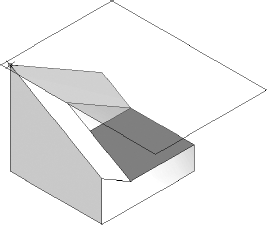
- Two co-planer edges
Any two coplanar edges (see
mi_4a_044.ipt).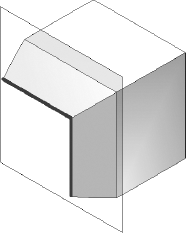
- Offset from face
Click a face, and drag in the direction of the offset. Enter the value of the offset (negative values are acceptable). (See
mi_4a_045.ipt.)
- Angle to face or plane
A part face or plane and any edge or line parallel to face (see
mi_4a_046.ipt).
- Tangent and parallel
A curved face and a planar face or work plane, in either order (see
mi_4a_047.ipt).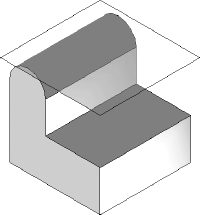
- Tangent through edge
A curved face and a linear edge, in either order (see
mi_4a_048.ipt).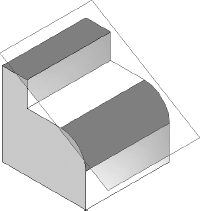
- Tangent to a cylinder
A line with ends coincident with the cylinder axis and edge and the tangent point on the cylinder edge (see
mi_4a_049.ipt).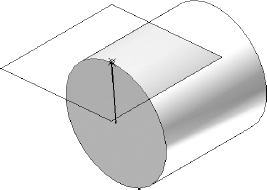
- Curve at a point on the curve
An edge or sketch curve and a vertex, edge midpoint, sketch point, or work point on the curve (see
mi_4a_050.ipt).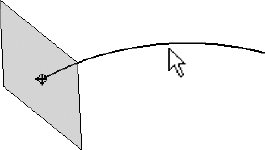
Here are some other points to remember about work planes:
You can right-click a work plane in the browser or the graphics window and then select Show Inputs to see how that work plane was created.
You can move work planes by clicking an edge and dragging. This will slide the work plane in the plane of its definition only.
When you place the mouse pointer on any corner of the work plane, a resize arrow appears, allowing you to drag the corner of the work plane to resize it.
You can also right-click and set a work plane to Auto-resize, allowing it to resize off the extents of the part as it changes.
Work planes have a positive and negative side to them. The Normal (positive) side has an orange tint, and the non-normal (negative) side has a blue tint. You can right-click a work plane and choose Flip Normal if needed.
If you do not have the geometry you need present when creating work planes, you can right-click and choose Create Axis or Create Point in order to create an "in-line work feature." In-line features are stacked in the Model browser and automatically set not to display.
When you start the Work Plane tool, you can right-click and choose Repeat Command to set the work feature tools to stay on until you right-click and choose Done. This helps when you are creating a lot of work features, because you do not have to keep clicking the button each time.
A work axis is a construction line of infinite length that is attached to a part based on the geometry used to create it. You can create a work axis on linear edges through circular faces and edges; through any combination of work points, midpoints, and vertex points; along 2D and 3D sketch lines; and at the intersection of work planes.
Work points may be created at the intersection of planes, surfaces, edges, work axes, 2D or 3D sketch lines, work points, and sketch points, in any combination. They can also be placed directly on sketch points, vertex corners, center points, edge midpoints, or grounded work points.
To see the practical application of the features, it's best to actually create them:
Open the part file named
mi_4a_052.ipt.Click the Plane button on the Work Features panel of the Model tab, click and hold down on the yellow face of the base plate feature, and drag out to create an offset plane. Enter 100mm for the offset value. You may need to use the ViewCube to change the view so you can see the yellow face.
In the browser, click the work plane node slowly twice, and rename it to OP-1.
Next expand the Origin folder in the model tree, right-click the z-axis, and choose Visibility.
Use the Work Plane tool again, and click the z-axis and the offset plane you just created (you can select these in any order). Enter 27.5. Remember that work planes are selected by their edges.
In the browser, click the work plane node slowly twice, and rename it to AP-1.
Expand the browser node for AP-1, and note that it has "consumed" the OP-1. You can right-click AP-1 and deselect Consume Inputs if you'd like.
Now you find the intersection of the two planes with a work axis. Click the Work Axis tool, and simply select both work planes.
In the browser, click the work axis node twice slowly, and rename it IA-1.
Double-click AP-1 to edit the angle value (double-click the browser node icon, not the text). Change the angle from 27.5 to 72.5, and click the green check mark (or press Enter on the keyboard).
Notice the work plane did not update. Changes to work plane definitions must be manually updated. In the Quick Access toolbar (at the top of the screen), click the Update button (it looks like a lightning bolt). Figure 4.44 shows the intersection axis and the model tree at this stage.
Next select the Work Axis tool, right-click, and ensure that Repeat Command is selected; this simply allows you to place multiple work features in succession without having to return to the menu to push the button each time.
Select the cylindrical face of each of the holes in the cylinder. This runs a work axis through the center of each hole. Rename these axes to CA-1, CA-2, and CA-3.
Select the Work Point tool, and then select OP-1 and CA-1, then OP-1 again and CA-2, and finally OP-1 a third time and CA-3. This places a work point at the intersection of the plane and axes.
Right-click the edge of OP-1, and choose New Sketch. This creates a new sketch on the work plane.
Right-click, and choose Slice Graphics (or press the F7 key) to temporarily clear the other geometry. Note that if you change your view to the opposite side of the sketch plane and then toggle the Slice Graphics option, you can change which side of the sketch is being sliced.
Select the Project Geometry tool on the Sketch tab, and select each of the work points and IA-1. This will create a sketch point at each work point and a line at the axis location. You could also get the same results by selecting only axes.
Create a sketch as shown in Figure 4.45 (All dimensions are 15mm. Use project geometry to get the work points into your sketch.)
Finish the sketch, and extrude the profile 10mm away from the other features.
Create a work axis from the tip of the obelisk-shaped feature to the corner of the plate-shaped feature. The resulting axis should run through the cylinder. Name the work axis PA-1.
Create a work point by selecting the cylinder first and then PA-1. Be sure to select PA-1 on the side of the cylinder closest to the plate corner to ensure that the work point is created on the correct side of the cylinder.
Select the Hole tool on the Model tab, and set the placement drop-down to On Point. Select one of the work points you created for the Point input and its corresponding axis for the Direction input.
Set the diameter to 10mm and the Termination drop-down to Through All, and then click Apply. Repeat this for each work point.
Note that the hole running through the cylinder may not cut as you would expect. To resolve this, select the crescent-shaped face, and then choose Delete Face on the Model tab on the Surface panel. Ensure that the Heal option is selected as shown in Figure 4.46, and then click OK.
Finally, right-click each work feature, and turn off its visibility. You can use the Ctrl key to select them all first as well. Work features should always have their visibility setting explicitly turned off at the part level so that their visibility can be controlled independently at the assembly level.
The Fillet tool in Inventor may seem daunting at first because of the number of buttons and combination of options, but once you understand the layout of the dialog box and the intended use of the options, you'll be able to create fillets of all types. There are three basic types of fillets:
- Edge fillets
These are fillets created based on selected edges.
- Face fillets
These are fillets created between two faces or face sets.
- Full round fillets
These are fillets that are tangent to three adjacent faces or face sets.
When you start the Fillet tool (on the Modify panel of the Model tab), it will default to edge fillets. You can switch the fillet type by using the buttons on the left of the dialog box.
Edge fillets are the most common type, and therefore naturally they have the most options. When Edge fillet is the active type, you'll see three tabs across the top of the dialog box, allowing you set the following Edge fillet subtypes:
- Constant
This has the same radius along the entire length of the edge.
- Variable
This can have multiple radius sizes along the length of the edge.
- Setbacks
This defines the corner where multiple edge fillets come together.
On the Constant tab, you can select a group of edges and then set the radius and type. You can create a new size group by clicking the Click To Add row in the selection pane and changing the radius size. Figure 4.47 shows two constant fillets groups being created. In this case, each group contains only one edge, but they vary in radius. Note the pencil icon indicating that the row is being edited. No edges can be selected at this time. To set the row ready to select edges, simply click the pencil icon so that it changes to an arrow.
Also on the Constant tab you can change the selection method from Edge to Loop or Feature. Figure 4.48 shows the selection method set to Feature and the results of selecting a hole. Note that all edges created by the hole feature are selected.
You can also select All Fillets (inside corners) or All Rounds (outside corners) to apply fillets to a part quickly, where it makes sense to do so. Figure 4.49 shows the same part with the two options applied to it for comparison. Keep in mind that you can select all rounds and fillets at once, as well.
In contrast to constant-edge fillets are variable-edge fillets. To create variable fillets, you click the Variable tab and then select an edge to make it variable. By default, the start and endpoints are added to the right pane. You can add points by simply clicking the edge in the place or places you want to transition to a different radius.
Once points are selected, you can change the radius and position of each point. The number listed in the Position column is a decimal percent of the edge length rather than the length. For instance, Figure 4.50 shows a point has been added at 60 percent of the edge length coming off the start end.
Once you select edges, you can switch to the Setbacks tab and select corners to apply setbacks to. Setbacks are typically used for cast and molded parts where the corners cannot be too sharp.
On the Setback tab, select a corner using the Vertex pane first. Then enter a setback distance for each edge. Setback values should be no longer than the length of the edge they are placed on. You will typically get an error if you attempt to specify a value that is larger. If you click the Minimal check box, the setbacks will automatically adjust to the smallest length that can be built. Figure 4.51 shows a setback being created as well as the result.
Face fillets add fillets between two selected face sets. These faces or sets of faces do not need to share a common edge. You can adjust the radius once the fillet is previewed, but typically if you do not get a preview, it indicates an invalid selection set. You can add more faces or may need to use a different type of fillet solution.
Two options are selected by default:
- Include Tangent Faces
Use this option to allow the fillet to continue over tangent, adjacent faces. Deselect this to ensure that the fillet is only between selected faces.
- Optimized for Single Selection
Deselect this when making multiple selections per face set. When this is selected, the selection automatically changes from selection set 1 to selection set 2.
Figure 4.52 shows a face fillet created between the two dark faces.
Full round fillets can be used to quickly round over a feature without having to know the radius that would complete the full round. You can use this to create a full round on faces that are not parallel also. To create this type of fillet, simply select the faces in the order that they occur from side to center to other side, and the center face will be replaced with the radius face. Figure 4.53 shows a full round. The selection options are the same as described previously for the face fillet.
Using Inventor's Hole tool, you can create counterbore, countersink, spotface, and drilled holes with user-defined variables such as thread designation and drill point angle. You can also specify a simple hole, a tapped hole, a tapped tapering hole, or a clearance hole.
Two external files are related to the Hole tool. These are Thread.xls and Clearance.xls. Both files load at the time of installation to a Design Data folder in the install directory location, such as C:Program FilesAutodeskInventor 2010Design Data. If the Design Data folder has been relocated, you can determine its location by following these steps:
Go to the Get Started tab, and click Projects.
In the Project File editor, ensure that you are looking at the correct project, and locate and expand the Folder Options node in the lower pane.
Note the Design Data path listed.
If the Design Data path says = Default, then your project is reading the path from Inventor's options, so you should go to the Tools tab, click Application Options, and go to the File tab in the dialog box that opens. Note the Design Data path listed.
Once the path is determined, you can browse to the path and find the Thread and Clearance spreadsheets and make customizations as follows. To edit the thread spreadsheet, follow these steps:
Close Inventor.
Make a copy of the original spreadsheet, and store it in a safe location (this is just a precaution).
Open the
Thread.xlsfile in Microsoft Excel.To add or modify custom thread designations for an existing thread type, do the following:
Choose the worksheet you want to customize.
Edit the values in the Custom Thread Designation column to include your designations. These will then be available in the thread and Hole tool and can be recovered in hole notes in a drawing.
Edit cell B1 to change the name Inventor displays in the hole and thread tools.
Edit cell D1 to change the order that Inventor lists the thread types in the Hole and Thread tool dialog boxes.
To add a new thread type, complete these tasks:
Copy an existing worksheet of the same type (parallel or taper).
Rename the custom worksheet as required.
Delete most or all of the rows below row 3. You may want to keep at least one row to use as a reference, at least temporarily.
Add rows as required.
Edit cell B1 to change the name Inventor displays in the Hole and Thread tools.
Edit cell D1 to change the order that Inventor lists the thread types in the Hole and Thread dialog boxes.
Hover your mouse pointer over cell A1 to see the tool tip containing the letter designations, and mark your sheet as appropriate.
Save the spreadsheet.
Restart Inventor. Changes are read when Inventor loads.
Modifying Clearance.xls is a very similar process.
You have four options for placing holes with the Hole tool:
From Sketch
Linear
Concentric
On Point
To explore these placement options, open the file named mi_4a_053.ipt from the Chapter 4 folder of the Mastering Inventor directory, and follow these steps:
Select the Hole tool on the Model tab.
You'll notice that the Placement option is set to From Sketch. This is because Inventor has detected that there are two sketches that are available for use. Click Cancel to exit the Hole tool.
Right-click Sketch5 in the Model browser, and choose Visibility.
Start the Hole tool again. This time Inventor detects that there is a sketch available and automatically selects the center point found in that sketch. Click the counterbore option.
Set the counterbore as shown in Figure 4.54, and then click OK.
Right-click Sketch5, turn the visibility back on, and then click the Hole button again. Notice that it selects the center points automatically again. This is helpful; however, you do not want the hole in the hex-shaped cutout to be the same size as the others is this sketch. Hold down the Ctrl key, and click the center point at that location to remove it from the selection.
Choose the spotface option, and notice that it is essentially the same as the counterbore with the exception of the depth measurement. In the spotface, the depth is measured from the bottom of the bore. Set the spotface as shown in Figure 4.55, and click OK.
Since you removed the one center point before placing the spotface holes, you will reuse that sketch to place the next hole. To do so, that sketch must be visible. The Hole tool has toggled the visibility back off, so locate Sketch5 again, and make it visible.
Place a simple drilled hole using the center point in the hex-shaped cutout, set the termination to Through All and the diameter to 9mm, and click OK. Then turn the visibility of the sketch off one last time.
Start the Hole tool again. You'll note that because there are no longer any visible sketches, the From Sketch option is no longer the default placement option. Set the placement to Concentric, and select the top face of the part for the Plane input.
Next you need to specify a concentric reference. Select one of the yellow faces (or the circular edge of the yellow face).
Set the hole to the countersink option, and then set the inputs as shown in Figure 4.56. Click Apply (not OK just yet).
Set the plane, use the other yellow face to place another countersink, and then click OK.
Change your view so that you can see the work point at the work axis intersection of the green face.
Start the Hole tool again, and set the placement option to On Point.
Select the work point for the point input and then the work axis for the direction. Flip the direction if needed, using the button next to the Termination drop-down.
Leave the hole at the simple drilled option, and set the Termination drop-down to To.
For the To selection, click the bore face of the counterbore hole, and click the Terminate Feature check box.
Click the Clearance Hole option, set the options as shown in Figure 4.57, and click OK.
Rotate the part so that you can see the underside, and zoom in on the feature with the red face.
Start the Hole tool again, and select the red face for the Face input.
Next select one of the longer straight edges for Reference1, and set the dimension to 8mm. Select one of the shorter edges, and set the dimension to 12mm.
Set the termination to Through All and the hole type to Taper Tapped Hole.
Choose Din Taper from the Thread Type list, set the size to M5, and then click OK. You'll note that the hole is cut with the appropriate taper.
You can set tolerances for hole dimensions in the Hole dialog box. When setting a hole dimension, right-click a dimension edit box, and then select Tolerance, as shown in Figure 4.58.
You can use these general steps to access the tolerance settings:
In the Tolerance dialog box, change the values as desired:
In Precision, click the arrow to set the decimal precision of the dimension.
In Evaluated Size, select Upper, Nominal, Median, or Lower to use when evaluating the dimension. This will set the size at which the hole is actually created.
In Type, click the arrow, and select a tolerance type for the selected dimension.
Depending on your selection, enter values to set the upper and lower tolerance range and the tolerance for the hole and shaft dimensions (for Limits and Fits).
Click OK.
This will return you to the Hole dialog box. Keep in mind that although the value in the hole input will not change, the hole will be drawn to the tolerance you selected in the model. For instance, if the Upper option were selected in the hole shown in Figure 4.58, the hole would measure 6.012mm rather than 6.000mm.
You can use the Bend Part tool to bend a part based on a sketched bend line. You can specify the end of the part to bend, the direction of the bend, the angle, the radius, or the arc length. You can find the Bend Part on the Modify tab of the Model tab. By default it is hidden from view and must be accessed by using the flyout (the small black triangle on the Modify panel).
Here are some guidelines to be aware of when using the Bend Part tool:
Sketches used for bend lines must be visible and unadaptive and should be located on a plane or surface that contacts the part.
A sketched line on the top face of a part does not allow for the part to be bent down, only up, whereas a sketch that runs through the part allows the bend to be built up or down.
Bend Part does not account for bend allowances in the way that sheet-metal features do and therefore should not be used with sheet-metal parts.
You can specify the bend by Radius & Angle, Radius & Arc Length, or Arc Length & Angle.
Follow these steps to create a simple bend part:
Open the file named
mi_4a_058.ipt.Select the Bend Part tool from the flyout of the Modify panel.
Select one of the sketch lines as the bend line.
Adjust the arrow buttons so that just the end is bent up. Notice if you try to bend the end down, it will not work. This is because of the position of the sketch.
Set the radius to 100mm, and then click OK.
The bend will consume your sketch, so you will need to expand the Bend feature in the Model browser and then right-click the sketch and choose Share Sketch.
Create another bend to your specifications, experimenting with the other solutions.
Figure 4.59 shows the Bend Part tool in action.
- Set application options and settings for part modeling
Understanding the settings and options that apply to the modeling environment is essential for getting the results you want from Inventor.
- Master It
You want to configure your options and settings for your sketch environment and then back them up and/or distribute them to other workstations. How would you go about doing this?
- Create basic part features
In this chapter, you learned how to plan a workflow that allows you to create stable, editable parts that preserve the design intent.
- Master It
You need to create a fairly complex part consisting of many extrusions, revolves, sweeps, or lofts. In addition, you will need to create holes, fillets, chamfers, and other part modifiers. This part may need significant modification in the future by you or by other designers.
- Use the Extrude tool
The Extrude tool is one of the most common feature tools in the Inventor modeling tool set. Understanding the options and solutions available in this tool will prove useful throughout your designs.
- Master It
Imagine you need to create an extruded feature but don't know the exact length; instead, you know the extrude will always terminate based on another feature. However, the location of that feature has not been fully determined just yet.
- Create revolved parts and thread features
Creating revolved features and parts in Inventor can often resemble the creation of turned part and features in the real world. Applying thread features to a cylindrical face allows you to specify threads without having to actually model them.
- Master It
Let's say you have a part that you intend to fabricate on a lathe. Although you could create the part with a series of stepped circular extrusions, it occurs to you that the Revolve tool might work also.
- Create work features
Using work features, work planes, work axes, and work points enable you to create virtually any part or feature. Work features are the building blocks for sketch creation and use.
- Master It
Your design will require creating features on spherical and cylindrical faces. You need to precisely control the location and angle of these features.
- Use the Fillet tool
The Fillet tool has a great deal of functionality packed into it. Taking the time to explore all the options on a simple test model may be the best way to understand all the options.
- Master It
You are trying to create a series of fillets on a part. You create four sets of edge selections to have four different fillet sizes, but when you attempt to apply them, you receive an error stating that the feature cannot be built.
- Create intelligent hole features
Although you can create a hole in a part by sketching a circle and extrude cutting it, this is typically not the recommended approach.
- Master It
You need to create a part with a series of various-sized holes on a plate. You would like to lay out the hole pattern in a single sketch and then use the Hole tool to cut the holes to the sizes required. However, when you select the From Sketch option in the Hole tool, it selects all of the holes, so you're thinking you must need to sketch out the hole pattern as circles and then use the Extrude tool to cut them out.
- Bend parts
You can bend a portion of a part after you define a bend line using a 2D Sketch line. You can specify the side of the part to bend, the direction of the bend, and its angle, radius, or arc length.
- Master It
You need to create a model of a piece of rolled tube and would like to specify the bend direction, but when you use the direction arrow, you get a preview in only one direction.

